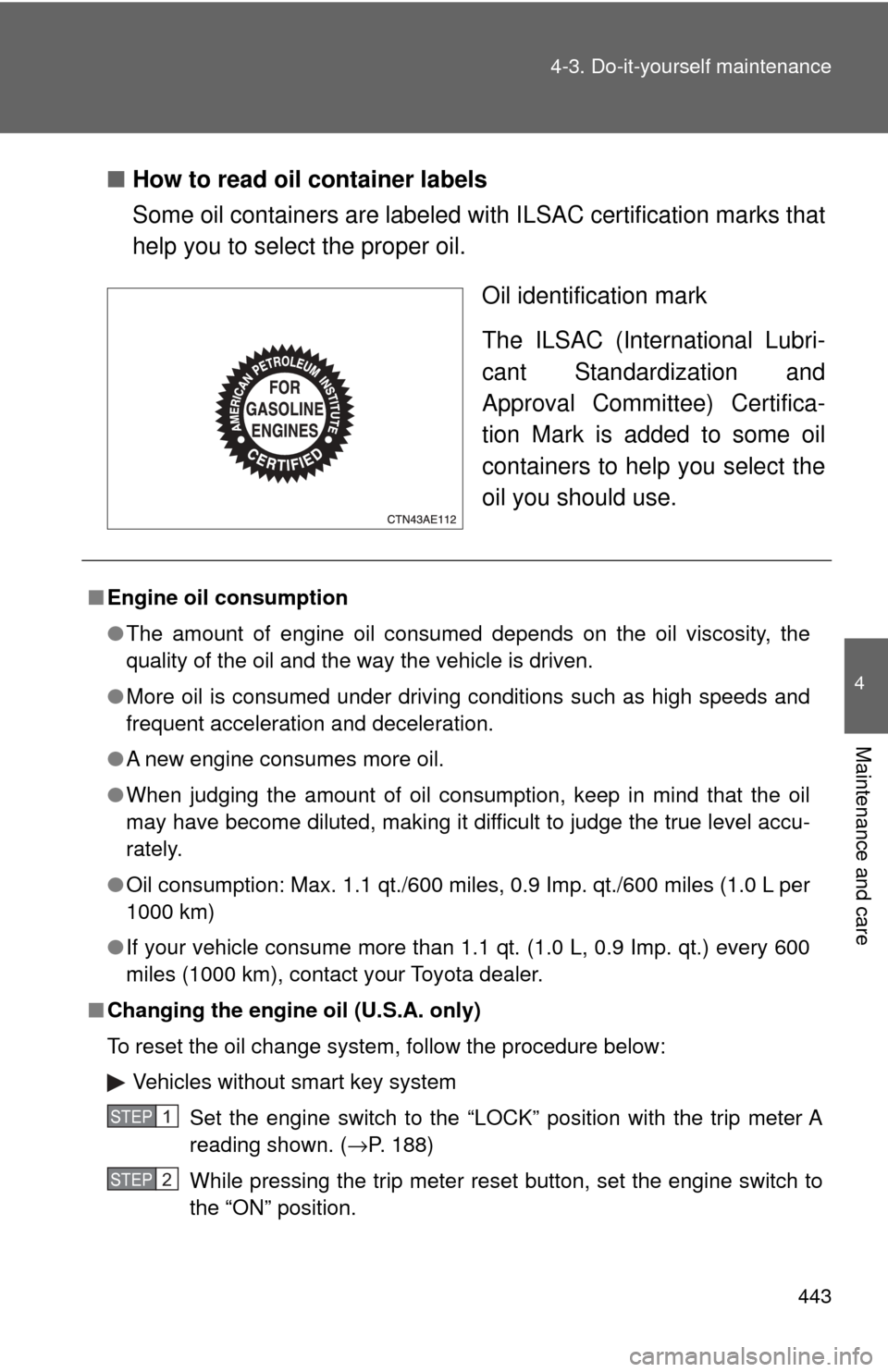Page 172 of 608
172 2-1. Driving procedures
NOTICE
■When encountering flooded roads
Do not drive on a road that has flooded after heavy rain etc. Doing so may
cause the following serious damage to the vehicle.
●Engine stalling
● Short in electrical components
● Engine damage caused by water immersion
In the event that you drive on a flooded road and the vehicle is flooded, be
sure to have your Toyota dealer check the following.
● Brake function
● Changes in quantity and quality of oil and fluid used for the engine, tran-
saxle, transfer (4WD models), differential (4WD models), etc.
● Lubricant condition for the propeller shaft (4WD models), bearings and
suspension joints (where possible) and the function of all joints, bearings,
etc.
Page 442 of 608
442 4-3. Do-it-yourself maintenance
■Recommended viscosity (2.7 L 4-cylinder (1AR-FE) engine)
SAE 5W-20 or 0W-20 engine oil
may be used. However, SAE
0W-20 is the best choice for
good fuel economy and good
starting in cold weather.
■ Recommended viscosity (3.5 L V6 (2GR-FE) engine)
Without towing package
SAE 5W-20 is the best choice for
good fuel economy, and good
starting in cold weather.
With towing package SAE 5W-30 is the best choice for
good fuel economy, and good
starting in cold weather.
*: If SAE 5W-30 oil is not avail-able, SAE 10W-30 oil may be
used. However, it should be
replaced with SAE 5W-30 at
the next oil change.
Outside temperature
Outside temperature
Outside temperature
Page 443 of 608

443
4-3. Do-it-yourself maintenance
4
Maintenance and care
■
How to read oil container labels
Some oil containers are labeled wi th ILSAC certification marks that
help you to select the proper oil.
Oil identification mark
The ILSAC (International Lubri-
cant Standardization and
Approval Committee) Certifica-
tion Mark is added to some oil
containers to help you select the
oil you should use.
■Engine oil consumption
●The amount of engine oil consumed depends on the oil viscosity, the
quality of the oil and the way the vehicle is driven.
● More oil is consumed under driving conditions such as high speeds and
frequent acceleration and deceleration.
● A new engine consumes more oil.
● When judging the amount of oil consumption, keep in mind that the oil
may have become diluted, making it difficult to judge the true level accu-
rately.
● Oil consumption: Max. 1.1 qt./600 miles, 0.9 Imp. qt./600 miles (1.0 L per
1000 km)
● If your vehicle consume more than 1.1 qt. (1.0 L, 0.9 Imp. qt.) every 600
miles (1000 km), contact your Toyota dealer.
■ Changing the engine oil (U.S.A. only)
To reset the oil change system, follow the procedure below:
Vehicles without smart key system
Set the engine switch to the “LOCK” position with the trip meter A
reading shown. ( →P. 188)
While pressing the trip meter reset button, set the engine switch to
the “ON” position.
STEP1
STEP2
Page 514 of 608

514 5-2. Steps to take in an emergency
Low washer fluid warning
light (vehicles without
multi-information display)Low level of washer fluid Fill the tank.
(U.S.A.) Engine oil replacement
reminder light (vehicles
without multi-information
display)
Illuminates for about 3 sec-
onds and then flashes for
about 12 seconds: Indicates
that the engine oil is sched-
uled to be changed.
Check and change the
engine oil if necessary.
Comes on and remains:
Indicates that the engine oil
should be changed. Check and change the
engine oil.
Tire pressure warning
light
When the light comes on:
Low tire inflation pressure
Adjust the tire inflation
pressure.
When the light comes on
after blinking for 1 minute:
Malfunction in the tire
pressure warning system Have the system checked
by your Toyota dealer.
Master warning light
(vehicles with multi-infor-
mation display)
A buzzer sounds and the
warning light comes on
and flashes to indicate that
the master warning system
has detected a malfunc-
tion. →P. 5 2 1
Warning lightWarning light/DetailsCorrection procedure
Page 515 of 608

5
When trouble arises
515
5-2. Steps to take in an emergency
*1: Open door warning buzzer:
The open door warning buzzer sounds to alert one or more of the doors is
not fully closed (with the vehicle having reached a speed of 3 mph [5 km/h]).
*2: Driver's and front passenger’s seat belt reminders:
The driver’s and front passenger’s seat belt reminders sound to alert the
driver and front passenger that his or her seat belt is not fastened. These
buzzers sound for 10 seconds after the vehicle has reached a speed of at
least 12 mph (20 km/h). Then, if the seat belt is still unfastened, the buzzer
will sound in a different tone for 20 more seconds.
*3: Vehicles without navigation system
*4: Vehicles with navigation system
■ Key reminder buzzer (vehic les without smart key system)
The buzzer indicates that the key has not been removed with the engine off
and the driver’s door opened.
■ Open moon roof reminder buzzer (vehicles with mult i-information dis-
play)
The buzzer indicates that the moon roof is not fully closed with the engine off
and the driver’s door opened.
■ Front passenger detection sensor and passenger seat belt reminder
● If luggage is placed on the front passenger seat, the front passenger
detection sensor may cause the warning light to flash, even if a passen-
ger is not sitting in the seat.
● If a cushion is placed on the seat, the sensor may not detect a passen-
ger, and the warning light may not operate properly.
■ Engine oil replacement re minder light (U.S.A. ⎯ vehicles without multi-
information display)
The engine oil replacement reminder ligh t will come on and flash at approxi-
mately 4500 miles (7200 km) after an oil change. When the distance driven
after an oil change exceeds approximately 5000 miles (8000 km), the light
will come on and remain on.
■ Changing the engine oil (U.S.A. only)
Make sure to reset the oil change system. ( →P. 443)